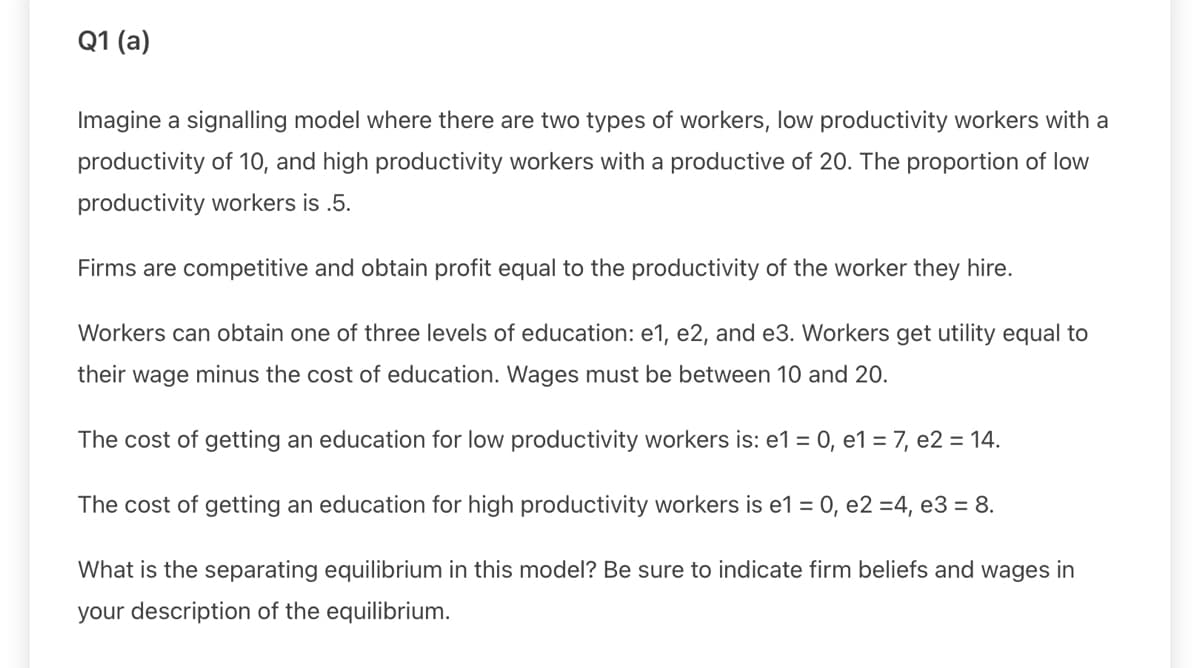Q1 (a) Imagine a signalling model where there are two types of workers, low productivity workers with a productivity of 10, and high productivity workers with a productive of 20. The proportion of low productivity workers is .5. Firms are competitive and obtain profit equal to the productivity of the worker they hire. Workers can obtain one of three levels of education: e1, e2, and e3. Workers get utility equal to their wage minus the cost of education. Wages must be between 10 and 20. The cost of getting an education for low productivity workers is: e1 = 0, e1 = 7, e2 = 14. The cost of getting an education for high productivity workers is e1 = 0, e2 =4, e3 = 8. What is the separating equilibrium in this model? Be sure to indicate firm beliefs and wages in your description of the equilibrium.
Q1 (a) Imagine a signalling model where there are two types of workers, low productivity workers with a productivity of 10, and high productivity workers with a productive of 20. The proportion of low productivity workers is .5. Firms are competitive and obtain profit equal to the productivity of the worker they hire. Workers can obtain one of three levels of education: e1, e2, and e3. Workers get utility equal to their wage minus the cost of education. Wages must be between 10 and 20. The cost of getting an education for low productivity workers is: e1 = 0, e1 = 7, e2 = 14. The cost of getting an education for high productivity workers is e1 = 0, e2 =4, e3 = 8. What is the separating equilibrium in this model? Be sure to indicate firm beliefs and wages in your description of the equilibrium.
Cornerstones of Cost Management (Cornerstones Series)
4th Edition
ISBN:9781305970663
Author:Don R. Hansen, Maryanne M. Mowen
Publisher:Don R. Hansen, Maryanne M. Mowen
Chapter15: Lean Accounting And Productivity Measurement
Section: Chapter Questions
Problem 4CE: Refer to Cornerstone Exercise 15.3. Choctaw Company provides the following additional information so...
Related questions
Question

Transcribed Image Text:Q1 (a)
Imagine a signalling model where there are two types of workers, low productivity workers with a
productivity of 10, and high productivity workers with a productive of 20. The proportion of low
productivity workers is .5.
Firms are competitive and obtain profit equal to the productivity of the worker they hire.
Workers can obtain one of three levels of education: e1, e2, and e3. Workers get utility equal to
their wage minus the cost of education. Wages must be between 10 and 20.
The cost of getting an education for low productivity workers is: e1 = 0, e1 = 7, e2 = 14.
The cost of getting an education for high productivity workers is e1 = 0, e2 =4, e3 = 8.
What is the separating equilibrium in this model? Be sure to indicate firm beliefs and wages in
your description of the equilibrium.
Expert Solution
This question has been solved!
Explore an expertly crafted, step-by-step solution for a thorough understanding of key concepts.
Step by step
Solved in 2 steps

Knowledge Booster
Learn more about
Need a deep-dive on the concept behind this application? Look no further. Learn more about this topic, accounting and related others by exploring similar questions and additional content below.Recommended textbooks for you

Cornerstones of Cost Management (Cornerstones Ser…
Accounting
ISBN:
9781305970663
Author:
Don R. Hansen, Maryanne M. Mowen
Publisher:
Cengage Learning

Principles of Accounting Volume 2
Accounting
ISBN:
9781947172609
Author:
OpenStax
Publisher:
OpenStax College

Managerial Accounting: The Cornerstone of Busines…
Accounting
ISBN:
9781337115773
Author:
Maryanne M. Mowen, Don R. Hansen, Dan L. Heitger
Publisher:
Cengage Learning

Cornerstones of Cost Management (Cornerstones Ser…
Accounting
ISBN:
9781305970663
Author:
Don R. Hansen, Maryanne M. Mowen
Publisher:
Cengage Learning

Principles of Accounting Volume 2
Accounting
ISBN:
9781947172609
Author:
OpenStax
Publisher:
OpenStax College

Managerial Accounting: The Cornerstone of Busines…
Accounting
ISBN:
9781337115773
Author:
Maryanne M. Mowen, Don R. Hansen, Dan L. Heitger
Publisher:
Cengage Learning

Excel Applications for Accounting Principles
Accounting
ISBN:
9781111581565
Author:
Gaylord N. Smith
Publisher:
Cengage Learning